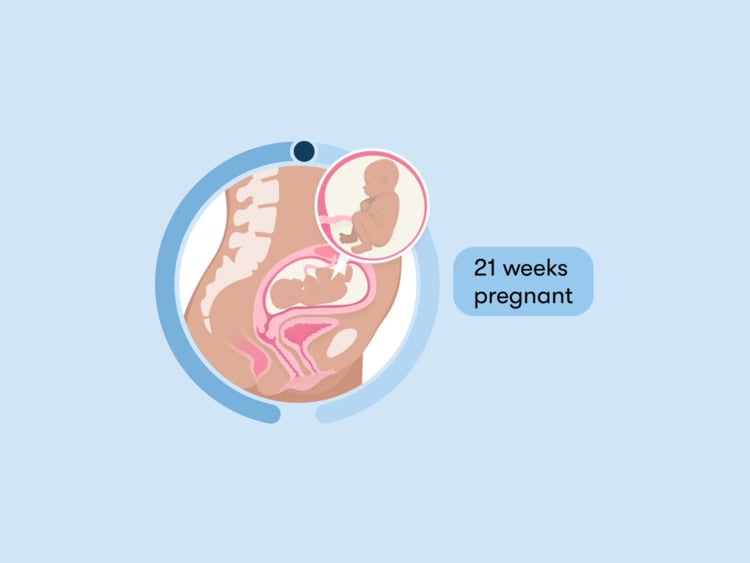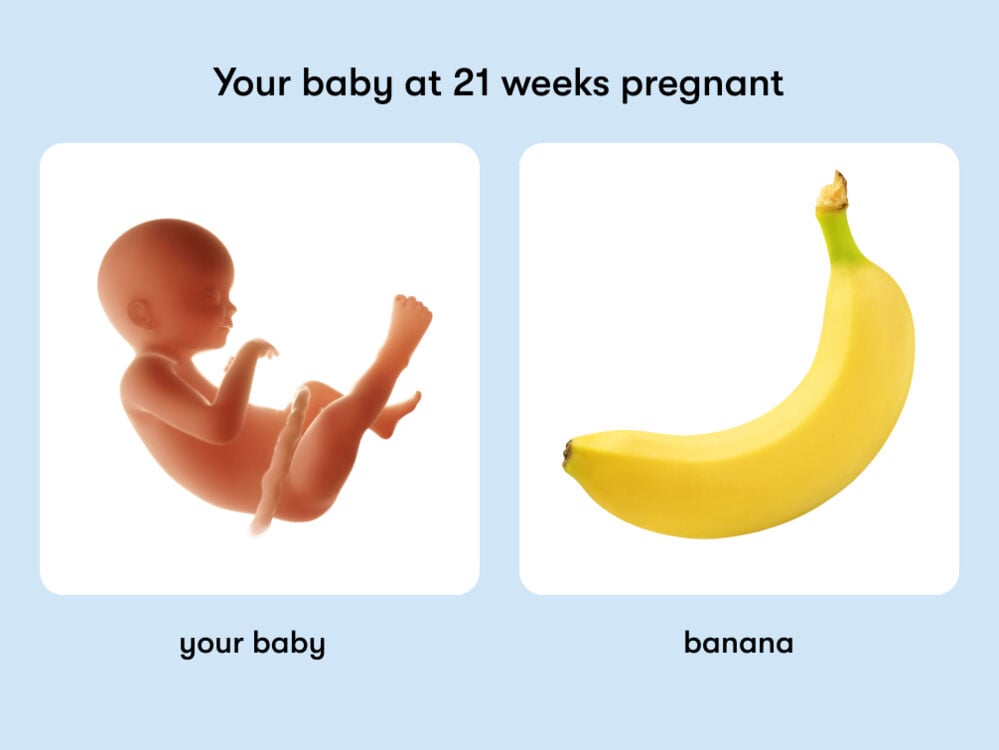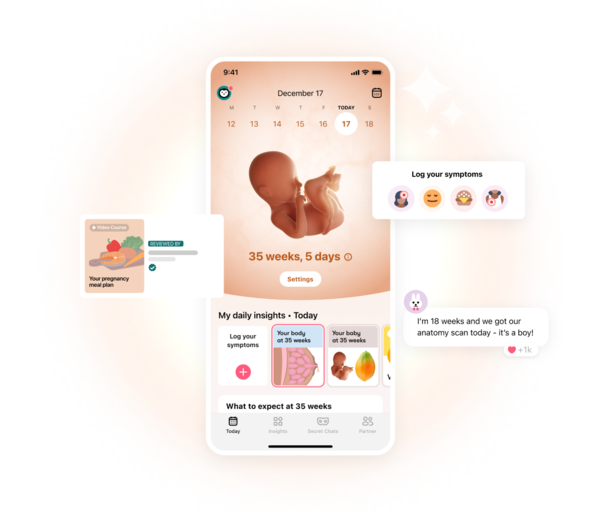From your growing pregnant belly to Braxton Hicks contractions, here’s the lowdown on being 21 weeks pregnant.
-
Tracking cycle
-
Getting pregnant
-
Pregnancy
-
Help Center
-
Flo for Partners
-
Anonymous Mode
-
Flo app reviews
-
Flo Premium New
-
Secret Chats New
-
Symptom Checker New
-
Your cycle
-
Health 360°
-
Getting pregnant
-
Pregnancy
-
Being a mom
-
LGBTQ+
-
Quizzes
-
Ovulation calculator
-
hCG calculator
-
Pregnancy test calculator
-
Menstrual cycle calculator
-
Period calculator
-
Implantation calculator
-
Pregnancy weeks to months calculator
-
Pregnancy due date calculator
-
IVF and FET due date calculator
-
Due date calculator by ultrasound
-
Medical Affairs
-
Science & Research
-
Pass It On Project New
-
Privacy Portal
-
Press Center
-
Flo Accuracy
-
Careers
-
Contact Us
21 weeks pregnant: Your guide to this week of your second trimester


Every piece of content at Flo Health adheres to the highest editorial standards for language, style, and medical accuracy. To learn what we do to deliver the best health and lifestyle insights to you, check out our content review principles.
At 21 weeks pregnant, you’re in your second trimester and about halfway through your pregnancy now (as pregnancy is considered to be full term if your baby is born between 39 weeks and 40 weeks and six days). While no two pregnancies are the same, some people report feeling pretty different once they enter the second trimester. For example, your symptoms may change, you may feel a bit more energetic, and you’ll likely notice that your bump is growing.
This can be an exciting time but also a little daunting. As you check off the weeks of your pregnancy, you may be mentally preparing for your baby’s arrival more and more. While your symptoms may have changed, your body is still undergoing some major developments. To help you understand what’s going on with your body and your baby at 21 weeks pregnant, a Flo expert outlines some of the things you might experience.
Your baby at 21 weeks pregnant
Baby can suck
At 21 weeks pregnant, your baby’s organs and bodily systems are continuing to develop, and they’re developing functions that will help them in the outside world. While they won’t need to suck and grasp anything while they’re in the uterus, they develop the ability to do this around 21 weeks. Babies use these skills during feeding once they’re born.
Gaining weight
You might have noticed that your bump has grown considerably throughout your second trimester. This is partially due to the fact that your baby has been gaining weight and getting bigger. Your baby may not have a lot of fat at this time, and they may still look a little bit wrinkled, but over the coming weeks and months, they will continuously gain weight.
How big is a baby at 21 weeks?
Length (crown to heel): 27.4 cm or 10.8 in.
Weight: 399 g or 14.1 oz
Size: Equivalent to a banana.
All measurements are approximate and vary within the normal range.

Your body at 21 weeks pregnant
Tracking your second-trimester symptoms using an app like Flo can help you learn what your own version of normal is during your pregnancy. Since no two pregnancies are the same, it can be tough to say what you should expect or what’s typical. However, you’ll have likely noticed changes to both your body and mood.
As your bump continues to grow, it can lead to some other bodily changes that you might not have expected, including backache and changes to your balance. Keep reading to find out more.
Changes to your balance
While you may have been expecting a growing bump and changes to your boobs, did you know that as your body changes, your sense of balance can too?
“Pregnant people can definitely start to feel like they’re more off balance. Their center of gravity is off, the belly is protruding because of their growing uterus, the ligaments in the pelvis loosen, and they may have gained some weight and can’t see their feet,” says Dr. Jenna Flanagan, academic generalist obstetrician and gynecologist, Beth Israel Deaconess Medical Center, Massachusetts, US. “So there are multiple reasons why someone might start to feel more off balance, but it’s just about slowing down a little if needed, taking your time, and trying not to put yourself in situations where there’s an overly high risk of falling.”
As your center of gravity shifts forward as your bump grows, it’s normal to feel a little clumsier than usual. Core exercises can help to strengthen your abdominal muscles and back. Similarly, prenatal yoga and Pilates could help you to increase your strength and flexibility. It’s a good idea to speak to your doctor before starting any new exercise regimes during pregnancy, just to be on the safe side.
Backache
It’s also fairly common to experience backache and pain during pregnancy, especially as your bump grows. Not only are you carrying around more weight than usual, but when you’re pregnant, the ligaments in your body naturally soften and stretch. This facilitates the growth of your baby and prepares your body for birth. This can put a strain on your back and pelvis, leading to pain.
Backache can be uncomfortable, but there are a few things you can do to try and relieve it at home, including:
- Bending your knees and keeping your back straight when you lift something from the floor and avoiding picking up heavy objects
- Taking a warm bath
- Using a pregnancy pillow to support your back and posture when you’re sitting down
You can also take over-the-counter painkillers to alleviate your pain, but it’s important to speak to your doctor before taking any new medication during pregnancy.
Your questions answered
What position is the baby in at 21 weeks?
As you watch your body change and your bump grow, you might be curious about what your baby is doing, including what position they’re in. This is hard to say since they move around a lot. They may be horizontal across your abdomen, have their head down with their feet toward your ribs, or be the other way around.
How often should I feel the baby move at 21 weeks?
For many parents, a comforting and exciting milestone is feeling their baby’s movements for the first time. Many people find that their baby’s movements feel stronger as their pregnancy progresses. They may feel like bubbles or butterflies in your tummy at first before feeling like true kicks and jabs.
Many people report feeling their baby move for the first time at around 16 to 24 weeks of pregnancy, so at this stage, you might have already started to pick up on a pattern of your baby’s movements. However, no two babies are the same, and while some may move around a lot, others may reserve their movements to a certain time of the day. Your placenta placement can impact how you feel your baby move. If it’s growing at the front of your uterus (this is called an anterior placenta) near your abdominal area, then movements may feel softer as the placenta is sitting between your baby and your belly.
If you’re ever concerned about your baby’s movements, don’t hesitate to speak to your doctor.
Are you 6 months pregnant at 21 weeks?
At 21 weeks pregnant, you’re at about the halfway mark of your pregnancy (as full term is considered to be anything between 39 weeks and 40 weeks and six days). However, you aren’t six months pregnant just yet; 21 weeks equates to around five months and one week.
Take a quiz
Find out what you can do with our Health Assistant
21 weeks pregnant checklist
Notice skin changes and stretch marks
As you move through pregnancy and your bump grows, it’s natural and common to develop stretch marks. They may appear red, pink, reddish-brown or dark brown depending on your skin tone, before settling into purple or silver. They might develop on your bump, thighs, or hips, and they occur because your skin is stretched as your bump and body grows.
You may feel self-conscious about changes to the way you look during pregnancy, and it’s so important to remember that you’re not alone. Getting your head around the idea of pregnancy can be a lot, and learning about your new body can be a process. Speak to your loved ones about how you feel, and your doctor may be able to recommend creams or body butters that are pregnancy-safe and could help your bump to feel moisturized and soft. While creams can’t get rid of stretch marks, they may make you more comfortable.
Take daily walks
Whether it’s exploring pregnancy yoga or getting out for a daily walk, it’s recommended that you do 150 minutes of exercise a week while expecting your baby. It can help to reduce any back pain you have, promote healthy weight gain during pregnancy, decrease your risk of developing gestational diabetes, and improve your overall health.
Your body is changing continuously during pregnancy, so you may want to adapt your workout routine to match that. Swimming, a walk, or yoga may help to get your heart rate up with more gentle movement. If you had a higher-intensity workout regime before you got pregnant, that may still suit you and be harmless. It’s good to inform your doctor about any exercises you’re doing during pregnancy to be sure that they’re safe.
Be aware of Braxton Hicks contractions
Between thinking about the kind of birth you might like to have and picking out baby names, there are lots of ways you can prepare for your baby’s arrival, and your body goes through some of the same preparations. While you aren’t ready to give birth yet, you may have felt cramping in your belly that feels like how you’d imagine a contraction. These are Braxton Hicks contractions, which are sometimes called false labor. They’re your body’s way of practicing labor.
“Braxton Hicks contractions are benign sensations that can feel like uterine contractions, but the difference between those and a real contraction is that a Braxton Hicks contraction isn’t going to change the cervix. So, it’s not a part of true labor,” explains Dr. Flanagan. “So while they can feel alarming, they are fairly common.”
You might be curious as to how to differentiate a Braxton Hicks contraction from the real deal. Braxton Hicks contractions typically feel like sensations of tightness at the front of your bump that are irregular in timing. Real labor contractions differ as they initially last between 30 seconds and 90 seconds and can be felt in the middle of your back and wrapped around your abdomen, whereas Braxton Hicks can come and go at irregular intervals.
Braxton Hicks contractions typically go away by themselves. Dr. Flanagan also says, “Make sure to stay hydrated by drinking lots of fluids. If you’ve been on your feet or it’s been really hot, consider taking a break. Put your feet up and rest for a while. These are things that can often help.”
If you’re ever concerned about pain or cramping around your bump, speak to your doctor. They will be able to talk you through the potential causes.
Take vitamin C
As your body continues to grow your baby, it’s crucial to keep on top of the vitamins and minerals that will aid in their development, such as phosphorus, calcium, and iron. “I would say that a balanced intake of nutrients is important throughout pregnancy,” says Dr. Flanagan.
A great nutrient to make sure you get enough of is vitamin C, which protects cells and helps keep both you and your baby healthy. While you can take it as a supplement, your vitamin C levels can also be well maintained through a balanced diet and found in foods such as oranges and orange juice, red and green peppers, strawberries, blackcurrants, broccoli, brussels sprouts, and even potatoes. So now is a good time to get creative in the kitchen.
When to consult a doctor at 21 weeks pregnant
You don’t need to wait until your appointments if you have any concerns or questions about your pregnancy. However, at 20 weeks pregnant, you should contact your doctor immediately if you experience:
- Severe cramping
- Vaginal bleeding
- Changes in vaginal discharge
- Fever
- Dizziness and fainting
- Severe vomiting
- Severe headaches or blurry vision
- Intense heartburn
- A loss of liquid from your vagina or watery/mucus-like discharge (This could be a sign of premature labor.)
This isn’t an exhaustive list and just an example of some of the changes you should look out for. Some of these can be a sign of miscarriage or other health complications, so it’s essential that you speak to your doctor about the best next step for you. And if you’re ever worried about any other symptoms you experience during pregnancy, don’t hesitate to reach out to your health care provider.
The takeaway: 21 weeks pregnant
At 21 weeks pregnant, you may have seen your pregnancy symptoms change through the trimesters. As your bump grows, you might notice that your center of gravity has changed, and you feel more unsteady on your feet than before. Similarly, you may be learning what Braxton Hicks contractions are and the different vitamins and minerals that can support you and your baby.
You can download an app like Flo to better understand the different symptoms you may experience during the second trimester. It’s crucial to remember that no two pregnancies are the same. What’s typical for you may be different from your friends. If you have any questions about your pregnancy, reach out to your health care provider. They’ll be able to outline what’s going on with your body and your baby during this week of pregnancy.


Hey, I'm Anique
I started using Flo app to track my period and ovulation because we wanted to have a baby.


The Flo app helped me learn about my body and spot ovulation signs during our conception journey.


I vividly
remember the day
that we switched
Flo into
Pregnancy Mode — it was
such a special
moment.
Real stories, real results
Learn how the Flo app became an amazing cheerleader for us on our conception journey.
References
“Week 21.” NHS, www.nhs.uk/start-for-life/pregnancy/week-by-week-guide-to-pregnancy/2nd-trimester/week-21/. Accessed 3 July 2023.
“2nd Trimester Pregnancy: What to Expect.” Mayo Clinic, 9 Mar. 2022, www.mayoclinic.org/healthy-lifestyle/pregnancy-week-by-week/in-depth/pregnancy/art-20047732.
“Anterior Placenta.” Cleveland Clinic, my.clevelandclinic.org/health/diseases/23306-anterior-placenta. Accessed 3 July 2023.
“Back Pain during Pregnancy.” Journal of Midwifery & Women’s Health, vol. 62, no. 1, Jan./Feb. 2017, pp. 135–36, https://doi.org/10.1111/jmwh.12597.
“Back Pain in Pregnancy.” Johns Hopkins Medicine, www.hopkinsmedicine.org/health/conditions-and-diseases/staying-healthy-during-pregnancy/back-pain-in-pregnancy. Accessed 4 July 2023.
Cooper, Danielle B., and Lily Yang. “Pregnancy and Exercise.” StatPearls, StatPearls Publishing, 2023, www.ncbi.nlm.nih.gov/books/NBK430821/.
Cox, Jean T., and Sharon T. Phelan. “Nutrition during Pregnancy.” Obstetrics and Gynecology Clinics of North America, vol. 35, no. 3, Sep. 2008, pp. 369–83, https://doi.org/10.1016/j.ogc.2008.04.001.
Erlandson, Michael, et al. “Common Skin Conditions during Pregnancy.” American Family Physician, vol. 107, no. 2, Feb. 2023, pp. 152–58, www.aafp.org/pubs/afp/issues/2023/0200/skin-conditions-during-pregnancy.html.
Dattani, Mehul T., et al. "Endocrinology of Fetal Development." Williams Textbook of Endocrinology, edited by Shlomo Melmed et al., 12th ed., Saunders, 2011.
“How to Tell When Labor Begins.” The American College of Obstetricians and Gynecologists, May 2020, www.acog.org/womens-health/faqs/how-to-tell-when-labor-begins.
“How Your Baby Develops Week to Week.” NHS Inform, 25 Jan. 2023, www.nhsinform.scot/ready-steady-baby/pregnancy/your-baby-s-development/how-your-baby-develops-week-to-week.
“Kick Counts.” Cleveland Clinic, my.clevelandclinic.org/health/articles/23497-kick-counts. Accessed 3 July 2023.
Nicholson, James M., et al. “New Definition of Term Pregnancy.” JAMA, vol. 310, no. 18, 13 Nov. 2013, pp. 1985–86, https://doi.org/10.1001/jama.2013.277993.
“Prenatal Vitamins: Why They Matter, How to Choose.” Mayo Clinic, 19 Apr. 2022, www.mayoclinic.org/healthy-lifestyle/pregnancy-week-by-week/in-depth/prenatal-vitamins/art-20046945.
Reynolds, S. R. “The Uses of Braxton Hicks Contractions.” Obstetrics and Gynecology, vol. 32, no. 1, July 1968, pp. 134–40.
Sparks, Dana. “Women’s Wellness: What You Need to Know about Prenatal Yoga.” Mayo Clinic, 24 Jan. 2019, newsnetwork.mayoclinic.org/discussion/womens-wellness-what-you-need-to-know-about-prenatal-yoga/.
“Stretch Marks: Why They Appear and How to Get Rid of Them.” The American Academy of Dermatology Association, www.aad.org/public/cosmetic/scars-stretch-marks/stretch-marks-why-appear. Accessed 3 July 2023.
“The Biomechanics of Pregnancy.” Physiopedia, www.physio-pedia.com/The_Biomechanics_of_Pregnancy. Accessed 3 July 2023.
“Back Pain in Pregnancy.” NHS, www.nhs.uk/pregnancy/related-conditions/common-symptoms/back-pain/. Accessed 3 July 2023.
“Exercise in Pregnancy.” NHS, www.nhs.uk/pregnancy/keeping-well/exercise/. Accessed 3 July 2023.
“Pelvic Pain in Pregnancy.” NHS, www.nhs.uk/pregnancy/related-conditions/common-symptoms/pelvic-pain/. Accessed 3 July 2023.
“Vitamins, Supplements and Nutrition in Pregnancy.” NHS, www.nhs.uk/pregnancy/keeping-well/vitamins-supplements-and-nutrition/. Accessed 3 July 2023.
“Your Baby’s Movements.” NHS, www.nhs.uk/pregnancy/keeping-well/your-babys-movements/ Accessed 3 July 2023
“What Causes Stretch Marks during Pregnancy?” The American College of Obstetricians and Gynecologists, Oct. 2020, www.acog.org/womens-health/experts-and-stories/ask-acog/what-causes-stretch-marks-during-pregnancy.
“Your Baby’s Movements in Pregnancy.” Royal College of Obstetricians and Gynaecologists, www.rcog.org.uk/for-the-public/browse-all-patient-information-leaflets/your-babys-movements-in-pregnancy-patient-information-leaflet/. Accessed 30 June 2023.
“Urgent Maternal Warning Signs.” Centers for Disease Control and Prevention, 27 Feb. 2023, www.cdc.gov/hearher/maternal-warning-signs/index.html.
“Bleeding during Pregnancy.” The American College of Obstetricians and Gynecologists, May 2021, www.acog.org/womens-health/faqs/bleeding-during-pregnancy.
“Vaginal Discharge in Pregnancy.” NHS, www.nhs.uk/pregnancy/related-conditions/common-symptoms/vaginal-discharge/. Accessed 30 June 2023.
Friel, Lara A. “Fevers during Pregnancy.” MSD Manual Consumer Version, Sep. 2022, www.msdmanuals.com/home/women-s-health-issues/pregnancy-complicated-by-disease/fevers-during-pregnancy.
“Morning Sickness: Nausea and Vomiting of Pregnancy.” The American College of Obstetricians and Gynecologists, May 2020, www.acog.org/womens-health/faqs/morning-sickness-nausea-and-vomiting-of-pregnancy.
“Heartburn during Pregnancy.” Cleveland Clinic, my.clevelandclinic.org/health/diseases/12011-heartburn-during-pregnancy. Accessed 3 July 2023.
“Preterm Labor.” Mayo Clinic, 8 Feb. 2022, www.mayoclinic.org/diseases-conditions/preterm-labor/symptoms-causes/syc-20376842.
History of updates
Current version (28 July 2023)
Published (24 February 2019)
In this article

Get your personal guide to pregnancy with the Flo app
-
Follow your baby's growth week by week
-
Get expert info on symptoms, safe foods, and more
-
Chat with other parents-to-be




